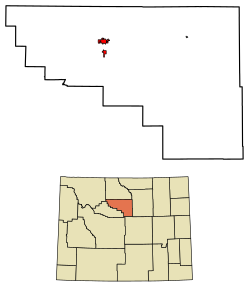2010 census
As of the census [2] of 2010, there were 5,487 people, 2,310 households, and 1,479 families living in the city. The population density was 1,203.3 inhabitants per square mile (464.6/km2). There were 2,473 housing units at an average density of 542.3 per square mile (209.4/km2). The racial makeup of the city was 89.9% White, 0.3% African American, 1.3% Native American, 0.6% Asian, 5.3% from other races, and 2.6% from two or more races. Hispanic or Latino of any race were 16.6% of the population.
There were 2,310 households, of which 29.6% had children under the age of 18 living with them, 49.7% were married couples living together, 9.9% had a female householder with no husband present, 4.5% had a male householder with no wife present, and 36.0% were non-families. 32.1% of all households were made up of individuals, and 13.6% had someone living alone who was 65 years of age or older. The average household size was 2.34 and the average family size was 2.95.
The median age in the city was 39.8 years. 25.2% of residents were under the age of 18; 7% were between the ages of 18 and 24; 23.5% were from 25 to 44; 26.5% were from 45 to 64; and 17.8% were 65 years of age or older. The gender makeup of the city was 48.5% male and 51.5% female.
2000 census
As of the census [3] of 2000, there were 5,250 people, 2,130 households, and 1,439 families living in the city. The population density was 1,274.1 people per square mile (492.0/km2). There were 2,334 housing units at an average density of 566.4 per square mile (218.7/km2). The racial makeup of the city was 89.47% White, 0.06% African American, 0.57% Native American, 0.84% Asian, 6.72% from other races, and 2.34% from two or more races. Hispanic or Latino of any race were 13.49% of the population.
There were 2,130 households, out of which 32.4% had children under the age of 18 living with them, 55.8% were married couples living together, 9.2% had a female householder with no husband present, and 32.4% were non-families. 29.2% of all households were made up of individuals, and 13.8% had someone living alone who was 65 years of age or older. The average household size was 2.41 and the average family size was 3.00.
In the city, the population was spread out, with 26.2% under the age of 18, 7.5% from 18 to 24, 25.3% from 25 to 44, 23.8% from 45 to 64, and 17.3% who were 65 years of age or older. The median age was 39 years. For every 100 females, there were 92.7 males. For every 100 females age 18 and over, there were 91.3 males.
The median income for a household in the city was $31,447, and the median income for a family was $42,453. Males had a median income of $31,411 versus $20,777 for females. The per capita income for the city was $17,208. About 9.7% of families and 15.4% of the population were below the poverty line, including 22.4% of those under age 18 and 15.6% of those age 65 or over.





